
A heritage railway or heritage railroad is a railway operated as living history to re-create or preserve railway scenes of the past. Heritage railways are often old railway lines preserved in a state depicting a period in the history of rail transport.
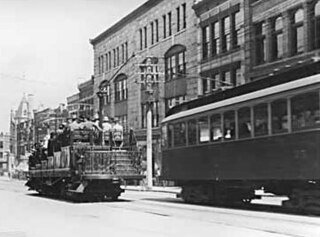
The British Columbia Electric Railway (BCER) was an historic railway which operated in southwestern British Columbia, Canada. Originally the parent company for, and later a division of, BC Electric Company, the BCER assumed control of existing streetcar and interurban lines in southwestern British Columbia in 1897, and operated the electric railway systems in the region until the last interurban service was discontinued in 1958. During and after the streetcar era, BC Electric also ran bus and trolleybus systems in Greater Vancouver and bus service in Greater Victoria; these systems subsequently became part of BC Transit, and the routes in Greater Vancouver eventually came under the control of TransLink. Trolley buses still run in the City of Vancouver with one line extending into Burnaby.
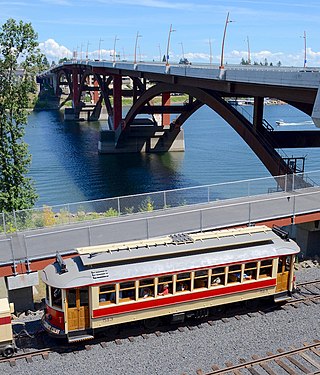
The Willamette Shore Trolley is a heritage railroad or heritage streetcar that operates along the west bank of the Willamette River between Portland and Lake Oswego in the U.S. state of Oregon. The right-of-way is owned by a group of local-area governments who purchased it in 1988 in order to preserve it for potential future rail transit. Streetcar excursion service began operating on a trial basis in 1987, lasting about three months, and regular operation on a long-term basis began in 1990. The Oregon Electric Railway Historical Society has been the line's operator since 1995.

A horsecar, horse-drawn tram, horse-drawn streetcar (U.S.), or horse-drawn railway (historical), is an animal-powered tram or streetcar.

The Oregon Electric Railway Historical Society (OERHS) is a non-profit organization in the U.S. state of Oregon, founded in 1957. It owns and operates a railroad museum for electric railroad and streetcar enthusiasts, and also operates a separate heritage streetcar line, the Willamette Shore Trolley.
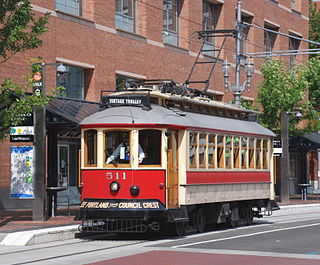
The Portland Vintage Trolley was a heritage streetcar service in Portland, Oregon, United States, that operated from 1991 to 2014. It operated on a portion of the MAX light rail system, and for a brief time also operated on the Portland Streetcar system, in downtown and nearby areas. Service was provided with replicas of a type of Brill streetcar, nicknamed the "Council Crest" cars, which last served Portland in 1950. The service was managed by Vintage Trolley Inc., a non-profit corporation, and the cars were owned and operated by TriMet, Portland's transit agency. For 18 of its 23 years, the service followed a 2.3-mile (3.7 km) section of what is now the MAX Blue Line, between Lloyd Center and the west end of downtown. In September 2009, the route was changed to a 1.5-mile (2.4 km) section of the MAX system, along the transit mall in downtown Portland, from Union Station to Portland State University (PSU).

The Yakima Valley Transportation Company was an interurban electric railroad headquartered in Yakima, Washington. It was operator of the city's streetcar system from 1907–1947, and it also provided the local bus service from the 1920s until 1957.

The National Capital Trolley Museum (NCTM) is a 501(c)(3) nonprofit organization that operates historic street cars, trolleys and trams for the public on a regular schedule. Located in Montgomery County, Maryland, the museum's primary mission is to preserve and interpret the history of the electric street and interurban railways of the National Capital region.

Powerland Heritage Park, formerly known as Antique Powerland, is a collection of museums and a self-described heritage site for power equipment, such as farm machinery, commercial trucks, trains, trolleys, construction equipment, logging equipment, and the engines which power them. It is located in Brooks, Oregon, United States, and is operated by the non-profit Antique Powerland Museum Association (APMA). It was initially established by a group of enthusiasts "dedicated to the preservation, restoration and demonstration of steam powered equipment, antique farm machinery and implements."
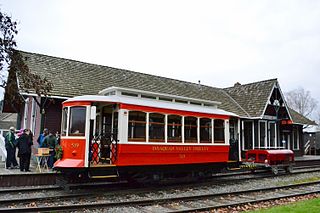
The Issaquah Valley Trolley (IVT) was a heritage streetcar line in Issaquah, Washington, United States. It was a project of the Issaquah History Museums. The IVT operated from the Issaquah Depot Museum building located at 78 First Ave, NE. The service operated on a trial basis in 2001–02 and then on a regular basis, seasonally, from 2012 to 2020.

Streetcars or trolley(car)s were once the chief mode of public transit in hundreds of North American cities and towns. Most of the original urban streetcar systems were either dismantled in the mid-20th century or converted to other modes of operation, such as light rail. Today, only Toronto still operates a streetcar network essentially unchanged in layout and mode of operation.

Council Crest Park is a city park in southwest Portland in the U.S. state of Oregon. Amenities include paved and unpaved paths, a dog off-leash area, picnic tables, public art, a view point, and a wedding site that can be reserved. The 43.51-acre (17.61 ha) park, operated by Portland Parks & Recreation, is open year-round from 5 a.m. to midnight. It was the site of an amusement park from 1907 until 1929.
The Gomaco Trolley Company is a manufacturer of vintage-style streetcars, located in Ida Grove, Iowa, United States. The company has supplied replica-vintage streetcars to several transit systems in the US, and has also restored and rebuilt authentic vintage streetcars for some systems.
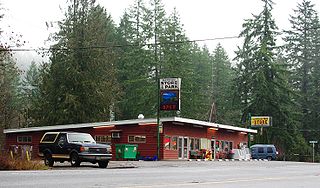
Glenwood is an unincorporated community in Washington County, Oregon, United States, northwest of Forest Grove on Oregon Route 6.
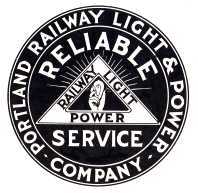
The Portland Railway, Light and Power Company (PRL&P) was a railway company and electric power utility in Portland, Oregon, United States, from 1906 until 1924.

The Portland Railway, Light and Power Sellwood Division Carbarn Office and Clubhouse, also known as Carmen's Clubhouse, in southeast Portland in the U.S. state of Oregon, is a former commercial transportation building listed on the National Register of Historic Places (NRHP). Built in 1910 by the Portland Railway, Light and Power Company (PRL&P), it was added to the register in 2002. The structure was associated with Portland's street railway and interurban system of the late 19th and early 20th centuries.

The Astoria Riverfront Trolley is a 3-mile (4.8 km) heritage streetcar line that operates in Astoria, Oregon, United States, using former freight railroad tracks along or near the south bank of the Columbia River, with no overhead line. The service began operating in 1999, using a 1913-built streetcar from San Antonio, Texas. As of 2012, the service was reported as carrying 35,000 to 40,000 passengers per year and has been called a "symbol" and "icon" of Astoria. The line's operation is seasonal, normally during spring break and from May through September.

The West Ankeny Car Barns Bay E is a former streetcar carbarn in Portland, Oregon, that is listed on the U.S. National Register of Historic Places. Completed in 1911, it was one of three buildings that collectively made up the Ankeny Car Barns complex of the Portland Railway, Light and Power Company (PRL&P), the owner and operator of Portland's streetcar system at the time. By 1978, the brick building had become the only surviving structure from the Ankeny complex and one of only two surviving remnants of carbarn complexes of the Portland area's large street railway and interurban system of the past, the other being the PRL&P's Sellwood Division Carbarn Office and Clubhouse.

The San Francisco Historic Trolley Festival was a heritage streetcar service along Market Street in San Francisco, California, United States. It used a variety of vintage streetcars and operated five to seven days a week, primarily in summer months, between 1983 and 1987. Sponsored by the San Francisco Chamber of Commerce and operated by the San Francisco Municipal Railway, it was the predecessor of the F Market & Wharves heritage streetcar line that opened in 1995. It used historic streetcars from several different countries, as well as a number of preserved San Francisco cars. The impetus behind the Trolley Festival was that the city's famed cable car system, one of its biggest tourist attractions, was scheduled to be closed for more than a year and a half for renovation, starting in September 1982. The Trolley Festival was conceived as a temporary substitute tourist attraction during the cable car system's closure.





























